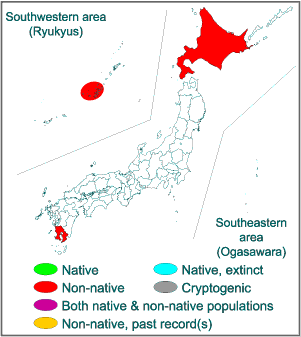
 Japanese |
English
Japanese |
English- Invasive Species of Japan >
- Fishes >
- Oreochromis mossambicus
| Basic information | ||
| Scientific name | Oreochromis mossambicus | (No picture) |
| Common names | Mozambique tilapia | |
| Higher taxon | Cichlidae, Perciformes, Actinopterygii | |
| Natural range | E Africa | |
| Habitat | Freshwater to Brakish. | |
| Invasion information | ||
| Range in Japan | Hokkaido, mainland of Kagoshima Pref., Okinawajima Is., Ishigakijima Is., and Ogasawara (Bonin) Islands. |

|
| Origin | Thailand | |
| Date | 1954 | |
| Route | Deliberate: Cultivated for food | |
| Impact | Potentially: Competition for food and nest space. Native organism(s) affected: Native freshwater fishes | |
| Regulation in Japan | No action for prevention, mitigation, control, or eradication. | |
| Introduced range in other countries | Taiwan, continental China, SE Asia, Borneo, Philippine, S Asia, Jordan, Yemen, Turkey, E Europe, Russia, Egypt, South Africa, W Africa, Australia, New Guinea, New Caledonia, USA, Mexico, Latin America, Caribbean islands, Pacific islands, Seychelles, Maldives, etc. | |
| Reference | Notes |
|
100 of the World’s Worst Invasive Alien Species |